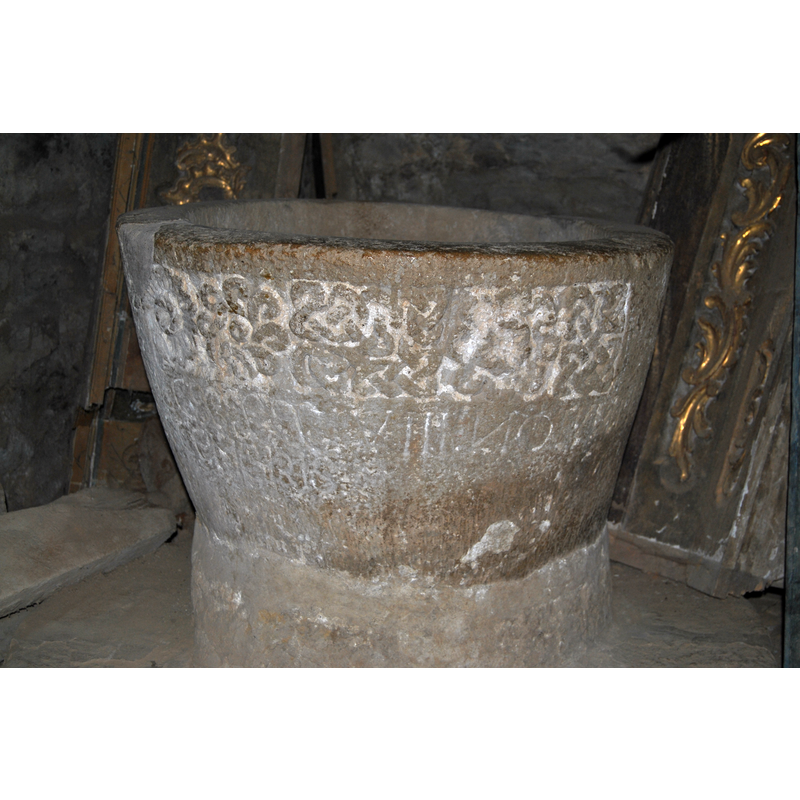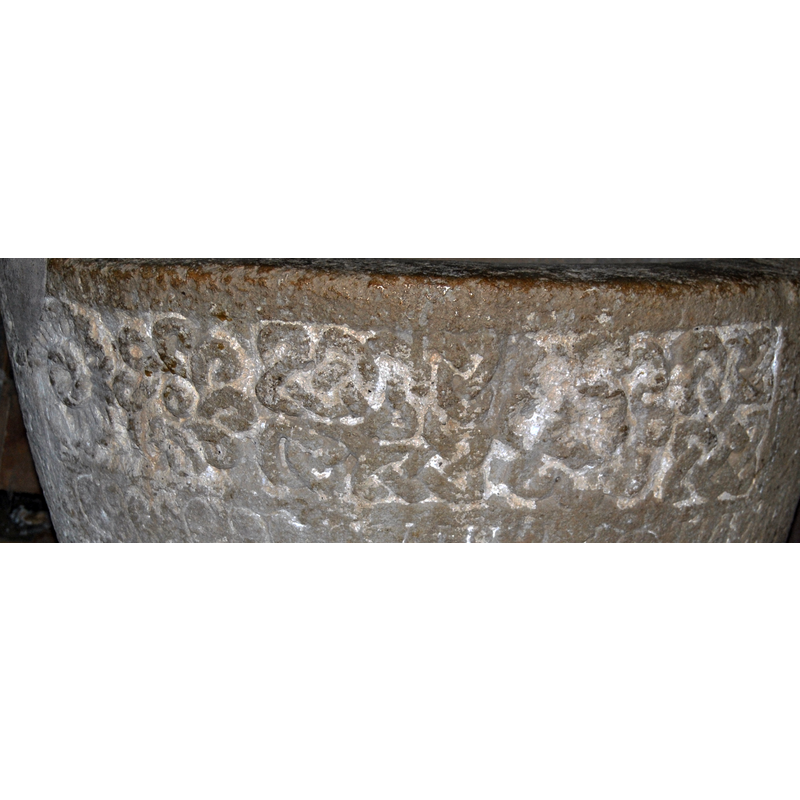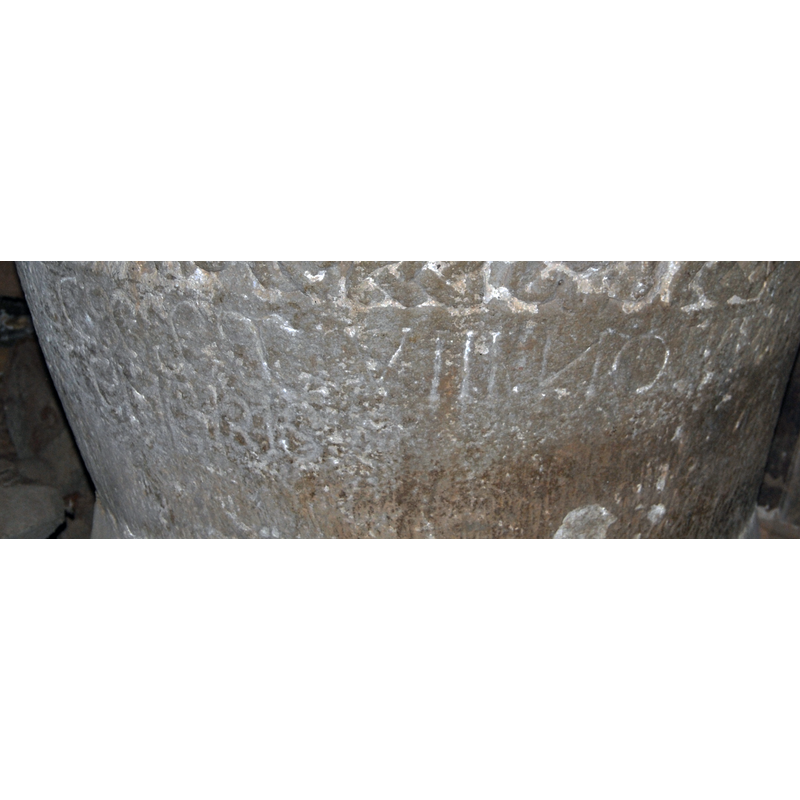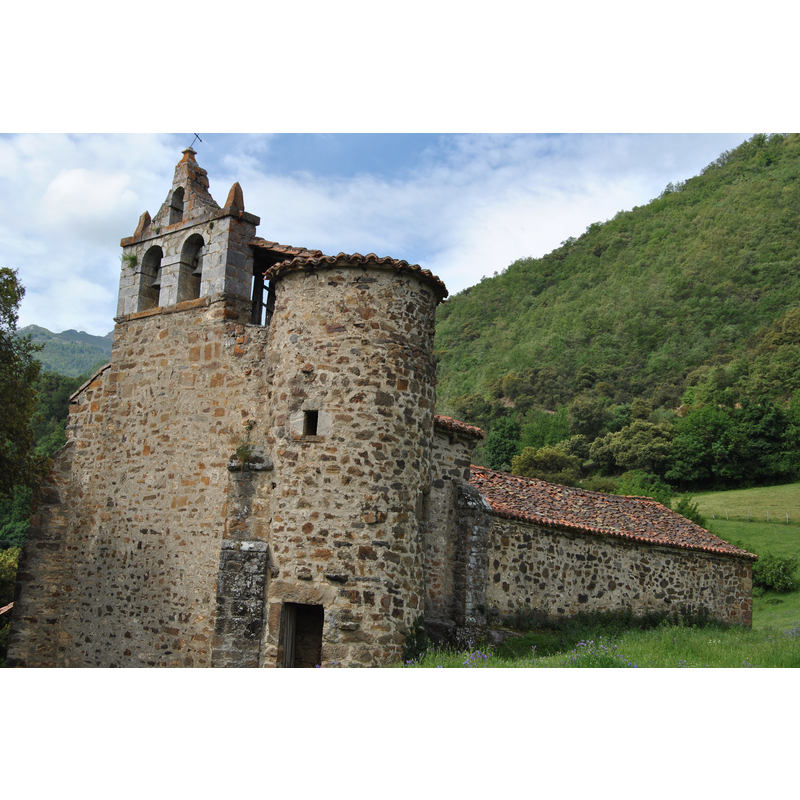Lomena / Lomeña

Image copyright © Fernando Garcia Gil, 2010
Standing permission
Results: 6 records
B1R01: design element - motifs - floral - rosette - 2
B1R02: symbol - sun?
B1R03: design element - motifs - interlace
B2R01: inscription
view of church exterior - southwest view
INFORMATION
FontID: 02054LOM
Object Type: Baptismal Font1
Church/Chapel: Iglesia Parroquial de San Juan Bautista [aka San Juan Degollado] [formerly La Asunción de Nuestra Señora?]
Church Patron Saints: St. John the Baptist
Church Location: 39572 Pesaguero-La Parte, Cantabria, Spain -- Tel.: +34 942 73 63 62
Country Name: Spain
Location: Cantabria, Cantabria
Directions to Site: Located off the CA-184, E of the N-621, in the municipality and 3 km NW of Pesaguero, Liébana, 129 km WSW of Santander capital
Historical Region: Santander province
Font Location in Church: Inside the church, at the W end of the nave
Date: ca. 1200?
Century and Period: 12th - 13th century, Late Romanesque
Credit and Acknowledgements: We are grateful to Fernando Garcia Gil for his photographs of church and font
Church Notes: the church appears in Madoz' Diccionario as La Asunción de Nuestra Señora
Font Notes:
Click to view
Described and illustrated in Karlsson (1989) and in Herrero Marcos (1996): bucket-shaped font stands on a wide round plinth; the upper part of the bowl has a broad band decorating the front side; in it are included some interlacing and two (?) large floral motifs: a daisy-like flower on the left and an eight-petal rosette on the right; underneath it has the date of its manufacture, 1200, incised on the stone [NB: the date may be a later addition]; a short, plain wide base links it to the equally plain wide plinth. The Circulo Romanico database [http://www.circuloromanico.com/diccionarios.php?glos_id=1744] [accessed 1 July 2010] records the inscription: "ERA MILESIMA CCXXXVIII NOTUM E DIE V IDUS DECEMBRIS", [i.e., 1200]. Described and illustrated in the Enciclopedia del románico [https://www.romanicodigital.com/sites/default/files/pdfs/files/cantabria_LOMEÑA.pdf] [accessed 9 December 2022] as a baptismal font dated to the year 1200 by an inscription: "La antigüedad románica se testimonia por su pila bautismal, colocada bajo el coro, en lugar difícil para analizarla. Es, sin embargo, pieza muy interesante, pues creemos que es la única pila en toda Liébana que aparece datada. La forma de la cuba es troncocónica; lleva en el frente una ancha franja rectangular, de 1,10 m de largo y 15 cm de ancho, que tiene esculpida de izquierda a derecha: trenzado doble; roseta octopétala con círculo central que encierra un tosco sogueado; otra rosácea semejante; otro trenzado más ancho; otra octopétala y trenzado más
estrecho. Debajo de esta franja relivaria, de poco resalte, y en dos líneas superpuestas, lleva la siguiente inscripción: ERA MCCXXXVIII: NOTUM DIE / V : IDVS : DECEMBRIS . Es decir, está fechada en el justo año 1200, principios del siglo XIII . Las medidas son: diámetro, 86 cm; borde, 10
cm; profundidad interior, 40 cm; altura de la cuba, 50 cm; primera base cilíndrica, 15 cm; segunda base, 11 cm".
COORDINATES
UTM: 30T 372393 4771694
MEDIUM AND MEASUREMENTS
Material: stone, type unknown
Number of Pieces: two?
Font Shape: bucket-shaped (mounted)
Basin Interior Shape: round
Basin Exterior Shape: round
Rim Thickness: 10 cm*
Diameter (inside rim): 66 cm [calculated]
Diameter (includes rim): 86 cm*
Basin Total Height: 40 cm*
Height of Base: 26 cm [15 + 11]*
Font Height (less Plinth): 66 cm [calculated]
INSCRIPTION
Inscription Language: numbers
Inscription Notes: the date given is 1238 'era", equivalent to 1200 A.D. [it may be a later addition]
Inscription Location: basin side
Inscription Text: 1) "ERA MCCXXXVIII: NOTUM DIE / V : IDVS : DECEMBRIS"
2) "ERA MILESIMA CCXXXVIII NOTUM E DIE V IDUS DECEMBRIS"
Inscription Source: 1) Enciclopedia del románico
2) Karlsson (1989: 121-123) and Circulo Romanico
REFERENCES
Herrero Marcos, Jesús, Arquitectura y simbolismo del románico de Cantabria, Madrid: Ars Magna, 1996
Karlsson, Lennart, "De gatfulla dopfuntsfragmenten i Sigtuna", LVIII, 4, Konsthistorisk tidskrift, 1989, pp. 143-150, 10 ill.; p. 121-123, ill. on p. 122


